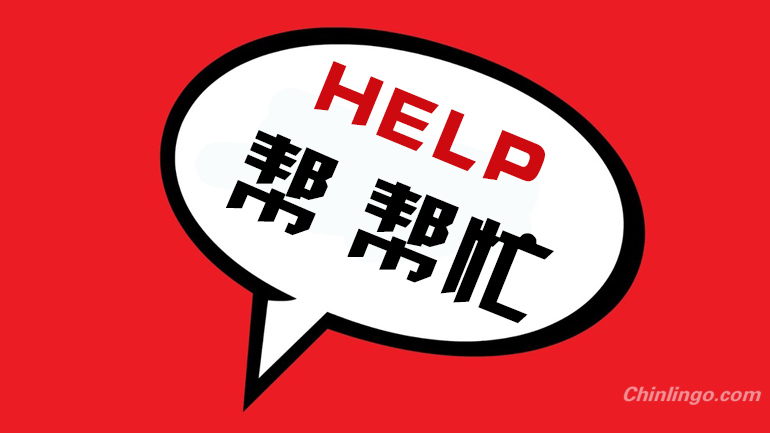
The words 帮 (bāng) and 帮忙 (bāngmáng) can both mean "help" in Chinese. However, they're used in slightly different ways and have different constructions. Because of that, how to use 帮 and 帮忙 correctly can be confusing at first.
"帮"和"帮忙"这两个词在中文里都是"help"的意思。不过,它们的使用方式有些不同,结构也不一样。因此,如何正确使用"帮"和"帮忙"在一开始的时候很让人困惑。
The main difference to remember is that 帮 can always take an object, and 帮忙 can in one structure but not in another.
记住,最主要的不同是:"帮"后可以跟宾语,而"帮忙"在有的结构中可以而在有的结构中不可以。
How to use 帮
帮 is a transitive verb. As mentioned above, that means that it can be used with an object. The basic structure for this is:
"帮"是个及物动词。如上所述,这意味着它可以与宾语连用。基本的结构是:
[noun] 帮 [noun]
The first noun is the subject of the sentence and the second is the object. So, the structure is equivalent to something like "the subject helps the object" in English. Let's have a look at some example sentences:
第一个名词是句子的主语,第二个是宾语。所以,句子结构有点类似于英语里的"the subject helps the object"。一起看看一些例句:
我来帮你吧。
wǒ lái bāng nǐ ba.
Let me help you.
你可以帮我一下吗?
nǐ kěyǐ bāng wǒ yīxià ma?
Can you help me?
我不要帮他。
wǒ bù yào bāng tā.
I don't want to help him.
帮 can also be used in a slightly more complicated structure, with a verb or verb phrase. This can be used to talk about helping people to do things.
"帮"也可以在稍微复杂的句子结构中使用,且跟上动词或动词词组。这种表达可用于谈论帮助他人做事。
[noun] 帮 [noun] [verb]
Note that the [verb] in the structure above is actually a verb phrase. That means it can be a mini-sentence of its own, containing a verb and maybe an object.
注意结构里的动词其实是动词词组。这意味着它可以是一个单独的短句,其中包含动词,或许还有宾语。
Let's have a look at some examples for this structure:
看看一些此结构的例子:
我帮我妹妹做作业。
wǒ bāng wǒ mèimei zuò zuo yè.
I help my little sister do her homework.
你可以帮我找找我的钥匙吗?
nǐ kěyǐ bāng wǒ zhǎo zhǎo wǒ de yàoshi ma?
Can you help me look for my keys?
他每天都帮我干活。
tā měi tiān dū bāng wǒ gàn huó.
He helps me with my work every day.
Notice how the verb phrase can include an object of its own, almost making it a mini-sentence. This makes the 帮 structure quite easy to use, as you can combine it with other sentence patterns you know.
注意,这里的动词词组可以有自己的宾语,几乎可以单独成短句。这使得"帮"的结构使用简单,因为你可以将它和其他你所知道的句子规律结合起来。
When 帮 means "for" and not "help"
A common use of 帮 in Chinese is to talk about actions that are done for other people. The structure is exactly the same as above, but it doesn't mean "help" in English. This use of 帮 isn't about people co-operating to do something together ("help"), it's about one person doing something on behalf of another ("for").
"帮"的一个常见用法是谈论为别人而付出的动作。结构和上述的完全一样,但是它的意思不是英语里的"help"。这里"帮"的用法不是关于大家协作一起完成某事,而是指一个人为了另一个人做了某事。
Let's have a look at some example sentences for this use of 帮:
一起看看"帮"的这个用法的一些例句:
你去邮局的时候可以帮我寄这个吗?
nǐ qù yóujú de shíhou kěyǐ bāng wǒ jì zhège ma?
Could you post this for me when you go to the post office?
我的秘书常常帮我安排开会。
wǒ de mìshū chángcháng bāng wǒ ānpái kāihuì.
My secretary often arranges meetings for me.
帮我打开窗户吧!
bāng wǒ dǎkāi chuānghù ba!
Could you open the window for me?
她昨天帮我修了自行车。
tā zuótiān bāng wǒ xiūle zìxíngchē.
Yesterday she fixed my bike for me.
Sometimes it may be ambiguous as to whether 帮 means "for" or "help". In those situations you simply have to work from context.
有时或许无法清晰区分"帮"的意思是"for"还是"help",这种情况下,你只需参照语境。
How to use 帮忙
Unlike 帮, the word 帮忙 can be transitive (can take an object) or intransitive (can't have an object) depending on the structure it's used in. Let's have a look at these two structures separately.
与"帮"不同的是,"帮忙"这个词可以是及物动词(可跟宾语)也可以是不及物动词(不可跟宾语),这取决于它所使用的结构。一起分别看看这两种结构。
When 帮忙 is intransitive
This is probably the simpler of the two 帮忙 structures. The structure is:
这也许是"帮忙"的两种结构里较为简单的。结构是:
[noun] 帮忙 [verb]
The verb here could also be a verb phrase. The important thing to note with the structure above is that there's no space for an object. In other words, this structure is intransitive.
这里的动词也可以是动词词组。使用上面的结构需要留意的重要一点是不能带上宾语。换句话说,这个结构是不及物的。
Let's have a look at some example sentences:
一起看看一些例句:
你来帮忙做饭吧!
nǐ lái bāngmáng zuò fàn ba!
Come and help with the cooking!
请你帮忙开个门好吗?
qǐng nǐ bāngmáng kāi gè mén hǎo ma?
Would you please open the door for me?
我写信请你帮忙。
wǒ xiě xìn qǐng nǐ bāngmáng.
I'm writing to ask you a favor.
When 帮忙 is transitive
You can use 帮忙 with an object in the structure below. In this structure, 帮忙 is a separable verb. That means that to add you extra information (such as an object) in between the two characters, rather than after them.
你可以在下面的结构里用"帮忙"跟上宾语。这个结构里,"帮忙"是个可分离的动词。这意味着你要在两个字中间加上额外信息(如宾语)而不是在它的后面。
帮 [other stuff] 忙
"Other stuff" here includes the object for 帮忙 or any other information that you might want to attach to the verb. It all goes in between 帮 and 忙.
这里的"other stuff"包括"帮忙"的宾语或者其他你想跟在动词之后的任何信息。这些信息都是放在"帮"和"忙"之间。
Let's have a look at some example sentences for this structure:
一起看看这个结构的一些例句:
你可以帮我一个忙吗?
nǐ kěyǐ bāng wǒ yīgè máng ma?
Can you help me?
他帮了你很多忙。
tā bāngle nǐ hěnduō máng.
He helped you a lot.
警察帮了我们一个大忙。
jǐngchá bāngle wǒmen yīgè dàmáng.
The police helped us a lot.
With this structure, the object can only be a pronoun; you can't put any other nouns in there as the object.
使用这个结构的话,宾语只能是代词,不能在这里使用其他任何名词作为宾语。
Translated from: ChineseBoost
Please visit Chinlingo for Chinese learning.



 闽公网安备 35020302035673号
闽公网安备 35020302035673号
0 responses on "How to use "帮" and "帮忙" correctly in Chinese"